* (Halloween countdown post #9/rerun)
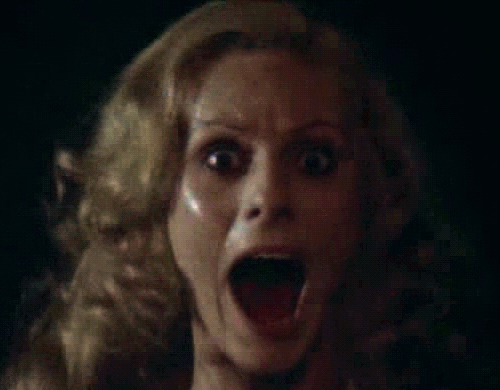
How did dark rides get started?
George LaCross: The forerunner to a single-rail dark ride was an “old mill,” a boat ride that went through a tunnel. When the old mills started cropping up around 1900, they were the first type of ride where you’d sit in a vehicle—a boat passing along a narrow channel—and see scenes or figures, called “stunts” in the industry. Some parks wanted these rides to be scary; others wanted them to be a trip through history, or a cruise around the world, that type of thing. These used mannequins—I think they were made out of wax, actually—to show the signing of the Declaration of Independence or Columbus landing on American soil. Some had dark areas for smooching, which is which why they got the nickname, “Tunnels of Love.”
Old-mill rides were very expensive because you had to have a tunnel with some type of a canal system, and then a wooden water wheel continuously spinning to push the water through it. And they were difficult to maintain. You had to constantly look for leaks in the wooden canal and patch them up during the off-season. I can’t even imagine what a nightmare it must’ve been re-boarding that stuff. Now, the ones that are still around have been converted to concrete canals, which are treated with special chemicals so they don’t leak. Back in the day, only the parks that were doing really well could afford to have old mills.
In the late 1920s, Tumbling Dam Amusement Park in Bridgeton, New Jersey, was struggling. The two owners, Leon Cassidy and Marvin Rempfer, desperately wanted to add some type of a dark attraction. And they were considering an old mill, but that was cost-prohibitive for them. Cassidy and Rempfer decided to build something on their own that wouldn’t involve the cost of putting in a wooden tunnel, something that used electricity.
So they took a “dodgem” car, also known as a bumper car—probably right off of their fleet—and modified the bottom of it to fit on a single-rail track. Then they ran this track through an older building that wasn’t being used. After a little tweaking, they got the dodgem to go around curves and so forth. I’m not sure exactly what they put in there, whatever they could come up with at the time, but they ended up with the very first dark ride, which they opened in 1928.
They ran a contest to name it, and the little girl who won called it Firefly, but they decided that might imply a fire danger, because they had electricity running through a wooden building. One of the first patrons came out of the dark ride, which had a lot of curves in it, and said, “Wow, I felt like I was twisted around like a pretzel.” So they changed the name to Pretzel.
And the earliest dark rides only had sound effects?
LaCross: Yes. These rides were all in pitch darkness. Pretzel patented many of the first sound effects, which were actually floor devices. You’d go over a lever on the track, and it would strike a cymbal, creating a sound like glass breaking. When the car would run over another lever, a container holding a bunch of ball bearings would get tipped up, and it’d sound like trash barrels tipping over. They had a string of bells hooked up, and they would just make a big clang when you went over that lever, which sounded like you were derailing.
Some of the earliest visual stunts they had—and some of them are still in operation—were motorless effects, lifted by the weight of the car. The sound effects weren’t necessarily right near these figures; those were usually positioned in the dark so you couldn’t see them. You’d be riding along in the Pretzel car in the dark, you’d hit a relay switch for the light, and then a lever for the figure itself. A small incandescent spotlight just focused on that black box would light up, and the cable would lift, say, a skull out of the bottom of the box.
For example, in the stunt called the “Jersey Devil,” you see what appears to be an empty box, and then the weight of the car forces a papier-mâché demon head to pop up inside it. For “Al E. Gator,” a lever on the track would tip a papier-mâché alligator on roller skates, and he’d lunge out at the riders. Some early stunts had limited gear motors, animating a head or hands going from side to side. Those would just go on, move for a few seconds, and then go back off again.
I read one of the earliest Pretzel stunts was just thread that hit your face.
LaCross: That was really innovative. It seems so simple, but Bill Cassidy—the second owner of Pretzel, the son of Leon—told us before he passed away that that was one of the gimmicks that he was most proud of. It was just a spool of thread. It would hang from a rafter in the ceiling, and it would rub up against people’s faces and creep them out. It’s supposed to be cobwebs, I guess, but it wasn’t an actual web. It was just a string, but you couldn’t see it. You weren’t expecting it. That got a real rise out people back then. It seems to me that just about every dark ride I rode in the 1960s had that. If it didn’t come factory-installed, I’m sure the park owners themselves would tack it up.
How did dark rides evolve over the years?
LaCross: First, they started making magnetic switches that they could put in the track to trigger stunts, and these were less likely to break than the mechanical levers. The most recent triggers used in dark rides are photo sensors called electric eyes. Some are set off by the motion of the car, but some are even more sophisticated, using light from reflectors on the car so the stunts are set off at the exact right time.
For sound effects, Pretzel had the noisemakers, but then some companies started producing 78-speed records that were just recordings of screams. You got a whole stack of them, and when one was done playing, the record player would drop down another one, so that you heard continuous screaming. When the eight-track came out, dark rides switched to one-track cassettes called “sound repeaters.” It would just be a small amount of tape that played the sound of a ghost or whatever that would coincide with the stunt itself and then stop at a particular point. And it would automatically be rewound for the next car that came by. The problem with those cassettes is that, again, if you’re continually playing a tape, stop-and-go, stop-and-go, it breaks. Plus, the atmospheric temperature had to be right. If it got too hot, the playback machinery would go crazy and start playing the sounds at high speed. Since then, those tapes have been replaced with digital cards.
How did the proliferation of television after World War II affect dark rides?
LaCross: I think TV enhanced the popularity of dark rides. The Spook-A-Rama operators in Coney Island, New York, did their own version of some of the old Universal monsters like Frankenstein, the Wolfman, and the Mummy, in addition to what was originally installed. That’s because in the late 1950s Universal gave TV stations permission to start showing some of their monster movies from the 1930s and ’40s. And Bill Tracy’s stuff was often inspired by old movies featuring villains and damsels in distress and the like.
Dark rides would keep up with the times. When the horror film called “The Tingler” came out in 1959, the Coney Island ride operators built a creature like that movie’s monster themselves and advertised it would be inside Spook-A-Rama. Around 1968, when Adam West used to play Batman in the campy TV series, the owner dressed up a male mannequin as Batman, and put him in the ride. Then he put a sign out that said, “See Batman!”
Why don’t we see as many of these old dark rides today?
LaCross: There was one pivotal moment in 1984, when a walk-through dark attraction called Haunted Castle caught fire at the Six Flags Great Adventure in Jackson Township, New Jersey, and eight teenagers, who were trapped inside, died. Most parks had perfectly safe funhouses, walk-through scary houses, and single-rail dark rides, but after this fire, park owners grew so afraid of something happening. All kinds of new restrictions were put on these things; from then on, they always had to have sprinkler systems, smoke alarms, and emergency exits.
In the past, many dark rides did end up burning down because they didn’t have sprinkler systems. For the most part, the fire started at another attraction and just happened to sweep into them. Some dark rides did catch fire themselves. There was one situation where one of the ride operators tried to circumvent the fuse by putting a penny into it, and that caused the fire in the control panel and set a big blaze off.
But I don’t think the tragedy was reflective of most operating dark rides and funhouses in the 1980s. Yet a lot of parks did purge their rides shortly after. At this point, that tragedy seems pretty much forgotten. All of the operating dark rides that I know of have sprinkler systems, partially because these rides are so valuable now and they’re such attention-grabbers. Not only do the park owners want to protect their patrons in case a fire breaks out when the ride is operating, but they want to make sure that it’s protected when it’s not in operation, because the vintage ones can’t be replaced.
The older devices have been retrofitted with new insulated wiring and motors, which are pretty much fireproof. That doesn’t take away from the age and charm of the stunt. It does put a little bit of a bogus slant on the ride when you see that emergency exit sign in the darkness. But they have to do it. You never can tell what might happen. If the rides didn’t have those, they wouldn’t be operating. — from Collectors Weekly
_____________
Hell n Back (1955 – 1963)
Asbury Park, NJ
‘This ride was located near where the Palace office and bathroom hallway was in the later years, inside the older building. After the Palace expansion of the 1950’s, this ride (in a newer rehash) ran way back, into the newer building to where the Wax Museum was, and right under the Fun House, on a long, straight run, all uphill! The ride’s facade featured some large “Ghosts” as well as the ” Funny, Fat Devil” poking a guy into a fiery death! There was also a rented Old King Cole “Laffing Man” that lead to even more “Ballyhoo” on the outside! It also had giant “Ghost” that waved into the air. There were large, animated “Heads with Fishbowl Eyes” that were made from defunct Donkey Ride parts. Some of the stunts included: A creepy “Witch” that was suspended by a wire, a “Guy and Coffin”, and lastly, a “Giant Octopus”, the last prop, that was to be used in later Dark Rides as well.’
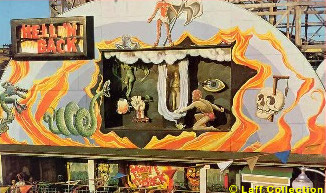
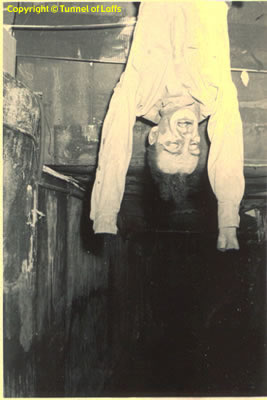
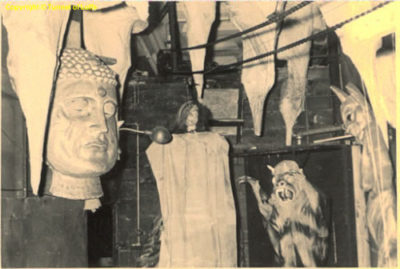
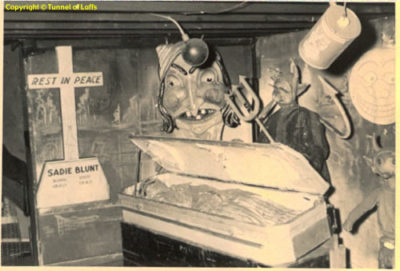
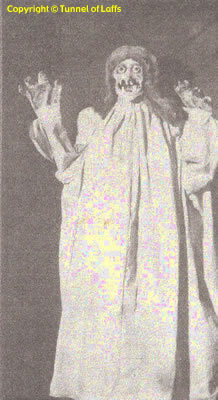

_____________
Dante’s Inferno (1983 – 2006)
Coney Island
‘Dante’s Inferno was decorated with a purple Cerberus in each tower, a werewolf out of one window, and skeleton warriors in another, its exterior’s centerpiece was a large devil holding a victim in his hand that is connecting to the tongue of an upside-down, lolling eyed creature, and a pitchfork in the other. The ride’s exterior resembled a castle, and its open area was decorated in graffiti style artwork includes Medusa’s severed head held by a Grim Reaper, as well as a mad scientist and several dragons. The passenger rode in a bumper car-like device and was sent through a maze of dark hallways. Most of the interior imagery was behind glass cases, including a dead woman rising off a table, a shaking mummy case, two gorillas, a werewolf popping out from behind foliage, skeletons, and various other horrors, in particular, scenes of a violent and gruesome nature such as a circular saw dismemberment and a man bound on all four limbs begging for help. Suspense was built by relatively long passages of nothing but darkness, strobes that simulate lightning, and sound effects, such as screaming, though some of these were lined with small, impish wall tiles. Little direct influence of Dante Alighieri’s Divine Comedy was to be found, though this was not always the case. The ride seems to have had no particular theme. Across from the first gorilla was an unlit display showing a man with a crown opening a window, which appears irrelevant to a horror-themed ride. The ride had elements similar to a roller coaster, including hard-whipping turns and, midway through the ride, coming outside and being pulled down a steep slope before being plummeted through another set of doors to more horrors. Early in the ride, one specter was lowered before the tracks, but otherwise there was glass (or in the case of the begging man, mesh) between the rider and the various scares. Unlike either the Ghost Hole or the Spook-a-Rama, the other Coney Island dark rides, nothing came directly at the rider, or threatens to do so. The ride lasted one minute and forty-five seconds. The admission price was $5.00 at the time Astroland closed.’
_____________
Earthquake: The Ride (1965 – 1984)
Cedar Point
‘Earthquake, the ride. Earthquake the ride opened in 1965. This ride was a dark ride based off of the 1906 San Francisco earthquake. It was in operation before moving to Cedar Point at Freedomland U.S.A. The ride was in operation through the 1984 season.’
______________
Land of the Giants (1938 – 1965)
Staten Island
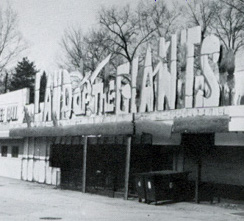
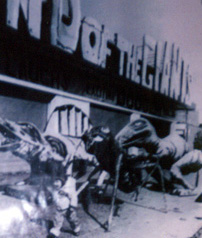
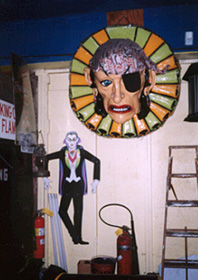
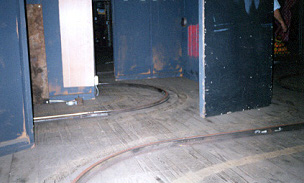
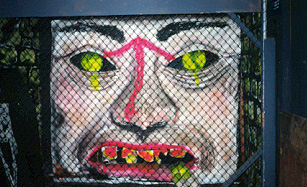
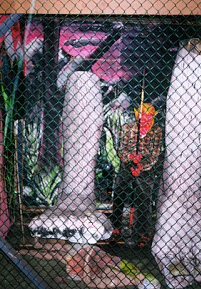
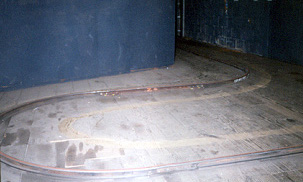
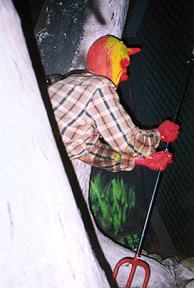
______________
Lumalusion (1979 – 2009)
State Fair of Texas
‘Everything was built in-house except for the 16 dark ride fiberglass car bodies, which were made from a Hush-Puppy car body mold that he acquired. Even the building itself was designed and built in-house. The building’s footprint was smaller than a typical Bill Tracy 2-story dark ride. Tracy’s buildings were approximately 70′ x 80′, where Lumalusion was 55′ x 60′ and included restrooms and shower facilities for the park employees. The smaller building created the need for the ramps to be steeper than in Tracy’s 2-story dark rides. This created an interesting challenge as the typical Hush-Puppy car’s motors were not strong enough to negotiate these steeper inclines. A custom built chassis had to be constructed with a more powerful motor for the drive system of the ride car. Specially built safeties were also installed that shut all of the cars down if any two of them got too close together. The interior was filled with optical and light based illusions. The facade was built completely on a level section of ground. Once finished, a crane lifted it into place on the completed building. After working almost 100 hours per week from January through June of 1979, Lumalusion officially opened on July 4, 1979. The ride has been a favorite at the State Fair of Texas and has remained almost completely unchanged since it opened more than 30 years ago. Lumalusion is a familiar “face”, but is also a unique, durable, and well-built ride in its own right that deserves its own place in dark ride history. This ride is a lasting tribute to the influence that Bill Tracy had on the dark ride industry and is expected to entertain guests at Fair Park for years to come.’
______________
The Witches Forest (1930 – ?)
Hunt’s Pier, NJ
‘Very little is known about this dark attraction. The photo of the ride was taken for Hunt’s Ocean Pier’s 1938 brochure.’
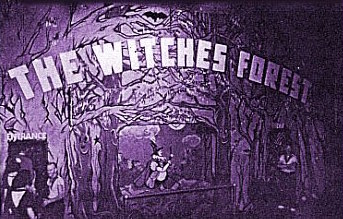
_____________
Golden Nugget Mine Ride (1957 – 1985)
Hunt’s Pier, NJ
‘Designed by John Allen and constructed by Hunt’s Pier staff, the Golden Nugget was a custom built enclosed coaster and Hunt’s premier ride for the 1960 season. A runaway mine car will whisk you through a western frontier complete with cowboys and Indians. Once up the lift hill, you would be taken on a short jaunt atop the structure where you could view an old prospector panning for gold… a covered wagon and the boot hill graveyard just before being dropped down the bottomless shaft! As you fly through the interior you would encounter miners and skeletons…giant bats and buzzards…even the classic near head-on collision with another mine car. Additional visual effects included toppling barrels, collapsing mineshafts, trick waterfall, and a roll through a spinning barrel of golden nuggets.’
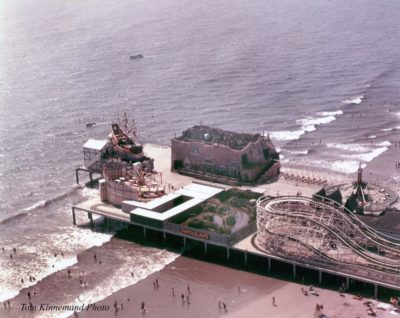
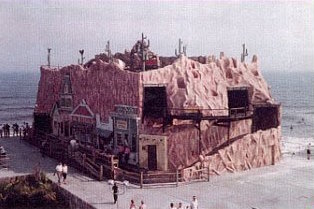

_____________
Dinosaur Den (1963 – 1969)
Holyoke, Massachusetts
‘As far as my memory can recall, the circuit began with the car curving to the right and slamming through a set of heavy wood doors. The car immediately turned to the left and after a few yards slammed through a set of heavy wood doors. The car immediately turned left and after a few yards slammed through another set of doors with a tiger painted on them. The car would then turn sharply right 90 degrees and begin heading uphill. The first stunt was on the right. The car swung again to the right, about 90 degrees, passing an emergency exit and continuing uphill. Another stunt was on the left. Another right turn, about 90 degrees, was met with the next prop on the right. The car would then turn 180 degrees to the left. Another stunt would be on the right. Then after turning 180 degrees to the right and passing a stunt to the left, the car leveled off. It would slam through a set of doors, then another set, travel out onto the overhang, pass by a stunt of a cave type person at the center of the overhang, swing around to the left 180 degrees past a Tiger stunt and then slam back through another set of doors. After passing through yet another set of doors, the car began its decent. It passed by a stunt on the left, turned to the right about 180 degrees, passed a stunt on the left and then swung around 180 degrees to the left. Another stunt was on the right, as was an emergency exit down a set of stairs. The car would turn 90 degrees left and pass by an enormous stunt on the right. It was about 20 feet long and dropped down through the floor. Then the car swung 180 degrees to the left, passed by a stunt on the left and leveled off. A 90-degree right turn revealed a stunt on the right. The car was then traveling at the far right end of the building. Then another 90-degree turn to the right was met with another set of doors. After passing through them, the car was traveling in a sort of tunnel. Looking to the left, you could see the station and the midway. looking to the right, you’d see an animated stunt. Originally, it was a caveman dunking a cavewomen into a big pot. The last operational stunt was a Frankenstein, which bobbed up and down behind a stone wall. After passing that prop, the car collided with another set of doors, turned left 180 degrees, went through more doors and back across the tunnel area, only this time a little closer to the station. More doors were hit! The car took a sharp turn to the right into the final set of doors and then back into the station.’
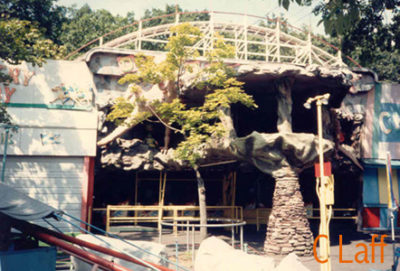
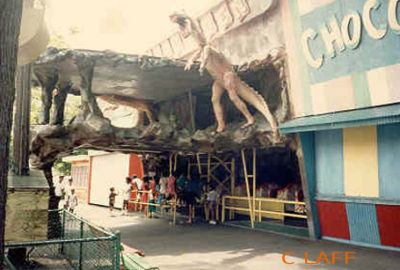

______________
The Scary House (1961 – 2004)
Balboa Beach, CA
_____________
The Ghost Hole (1989 – 1999)
Ocean City, Maryland
‘The Ghost Hole, a portable darkride that was a staple at Trimper Rides & Amusements for many years, offered a two-minute ride full of popup-style stunts and graffiti-style artwork destined to make any summer visitors turn their heads. Ghost Hole, formerly named “Geister Hohle”, was a German darkride that sat on Trimper’s side street beside the Matterhorn for nearly a decade. The stunts were quite primitive in nature when Ghost Hole sat on Trimper property, and consisted mainly of popup stunts using transistorized sirens and loud buzzers to scare the unsuspecting patrons during their two-minute adventure. Even though the ride was portable, the Trimpers still made the ride a pleasant one, filling the gaps with worthwhile stunts while making a constant effort to purchase new props every few years to keep the content fresh. The maintenance door that was entered when opening or closing the attraction was located on the front-center of the ride and was locked from the outside. The main entrance and exit of the ride, although clearly accessible to anyone walking by off-hours, was locked from the inside using deadbolts and steel bars.’
Outside
Inside
_____________
Laff In the Dark (1934 – 1992)
Rye, New York
‘In 1934, Harry Traver advertised Laff at a cost of around $18,000.00 which included a building, 12 cars, stunts made of plywood, steel track, and a front and building that measured 93 feet wide, 40 feet high and 60 feet deep The earliest known façade at Playland’s Laff in the Dark hosted animated elephant and alligator heads as well as a few plywood clowns. Inside the ride lurked the Traver/Chamber two-dimensional plywood stunts common in all the Laffs they created. The Trahanas family purchased the ride in 1963. Nick Trahanas’s father was no stranger to the amusement park business, having operated a candy confection business in Asbury Park, NJ. Shortly after the elder Mr. Trahanas purchased Rye’s Laff in the Dark, the stunt sequence was as follows: An original plywood Popeye, then the Man in a Coffin. Then a classic Spider and Web. Towards the back wall was a stunt that is remembered fondly by enthusiasts, the Running Rats Along a Beam stunt! The ride had a turn inward that led to an old African Native Man with Spear scene. Next up, was yet another fondly remembered prop, the ClassicTraver/ Chambers Fighting Cats. The Devil was next, followed by a Coffin That Rocked Open. A Man in Jail scene followed, and then came an old Dragon’s Head. Towards the front right-hand turn was a Skeleton that flew out at you. Next were a Gorilla and then a Witch, with outstretched hands. Onward you would go through the Spinning Barrel. Frankenstein, a figure built by Mr. Trahanas’s father, was at the end of the barrel. Around the turn inward was yet another sadly-missed Traver/Chambers classic: The Kicking Mule stunt, constructed of sheet metal and wood. All the old stunts were enhanced with the sounds of classic sirens, buzzers and bells. The ride cars were originally single- seaters, but were later converted by the Trahanas family to two-seaters.’

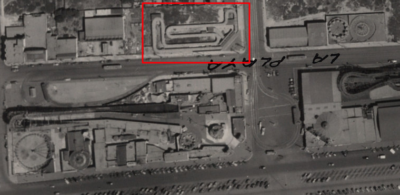
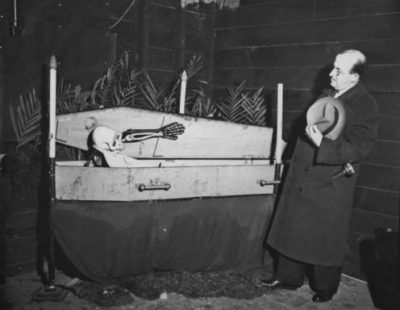
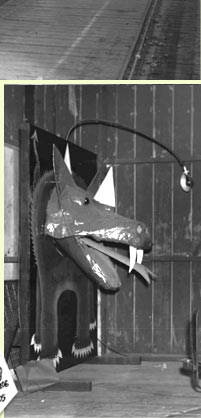
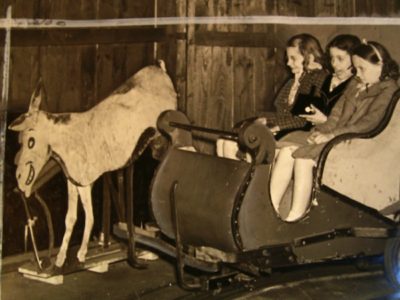
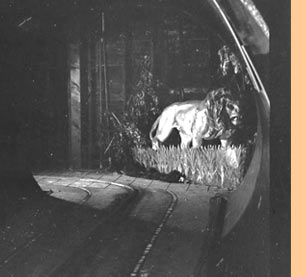
______________
House of Shock (1992 – 2014)
New Orleans
‘House of Shock had thrilled visitors for 22 years when co-founder Ross Karpelman announced that 2014 would be the last season for the institution. Despite the popularity of the devilish fall destination, profit margins were always pretty slim, Karpelman explained. Too slim when the weather was unkind to the partially outdoor amusement. In 2012, Hurricane Isaac wrecked the two-story outdoor stage where the House of Shock’s explosive pre-tour performances take place, requiring a laborious restoration. Then, Halloween night 2013 was a rain-out.’
Pre-show
Test ride with the lights on
_____________
Hells Poppin (1958 – 1962)
Muskogee, OK

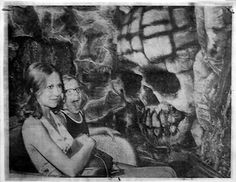
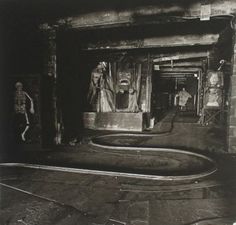
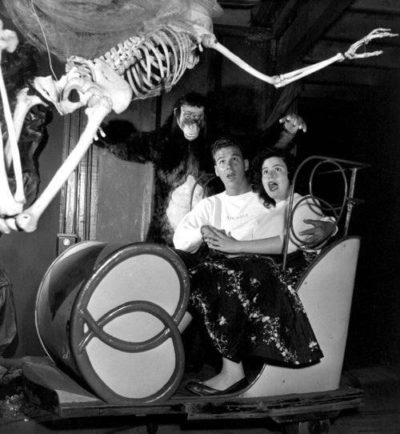
______________
Haunted Hotel (1978 – 2006)
Myrtle Beach, FL
‘The Haunted Hotel was the best dark ride in the entire region, and the only haunted house ride– all other haunted houses are walk-throughs. This ride was destroyed along with other fixed structures in the park during Feb.-March 2007, after operating for the last time on the Sept. 30, 2006 “Last Ride” event. Burroughs & Chapin was unable to sell this ride, so the fate of the props, and effects is not known. During its last season of operation, it had many maintenance problems- when I rode it in August, and at the Last Ride, many of the effects weren’t working, different ones each time. The Haunted Hotel was originally the “Haunted Inn”, built in 1978 by Funni-Frite of Pickerington (Columbus), OH, which made props for many haunted houses across the country. Funni-Frite started in the early 1960s as a contractor to Philadelphia Toboggan Company, to produce gags and effects for their funhouses. They also built portable rides for carnivals, constructing almost 500 before they closed in 1999. Funni-Frite is no longer in business; the company and its assets were sold at auction on January 15, 2000.’
____________
Flight to Mars (1968 – 1994)
Texas State Fair
‘If you were a kid around here between the late 1960s and mid-1990s, those three words conjure a very specific image. It’s not a rocket, but a face, an alien with a fedora, eye patch and missing teeth, its bottom jaw rising and lowering, silently laughing at those foolish enough to come near. The gargoyle hung from the facade of the Flight to Mars ride, a creaky, campy fright show that became a rite of passage for a generation. By the time you finally mustered the courage to buy a ticket, you probably were too old to be scared. More than a decade ago, Flight to Mars was sold and dismantled.’ While the ride is gone, the phrase lives on. A local arts group adopted the name Flight to Mars, and for his solo band, so did Pearl Jam guitarist Mike McCready.’
____________
The Spook (1960 – 1967)
Coney Island
‘The rider was pulled around in a car resembling an old wooden barrel. These barrels looked like connected cars, but separate from each other at the beginning of the ride, so the rider had to go in alone, passing paintings that change imagery, and a skeleton before the car itself forces the doors open. Inside, the ride was one large, poorly lit room. Some of the old views included zombies, the face of an ogre composed of light bulbs, a demon slashing an axe toward the rider, a man in a straitjacket being electrically shocked, heads popping out of barrels, and a gruesome man being killed in an electric chair. On the way out of the ride, stringy objects hang from the ceiling that provided an extra fright. The ride ran over ten minutes and was billed as the longest ride on Coney Island, and the longest spook ride in the world.’
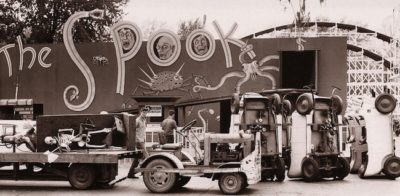
_____________
The Haunted House (1962 – 1988)
Ocean City, Maryland
‘Your coffin crashes through two sets of double-doors, bringing you face-to-face with a giant rat perched on a tree stump. As you approach, he leaps at you, squeaking with the help of a self-contained transistorized siren. To your left is the first of many banisters; this one lined with gyrating skulls bearing spider legs. Entering another set of double doors, you’re headed down one of Tracy’s famous crooked chambers. Tracy’s use of off-center framing and a deceptive illustration at the chamber’s end gives you the forced perspective of infinity. Adding further credibility to the gimmick, an unseen ramp tips your car to the side as the digital sound bite of creaking timbers plays on. Next, you’re sucked into a vortex – actually a bridge running straight through a rotating barrel lined with day-glo patterns. No ramps needed here. Apparently the vortex also has impacted one of the house’s rooms, as a quick turn to right reveals a woman awakening to find her whole bedroom turned upside down. All the room’s furnishings are mounted to the ceiling, including an end table with a lamp. It’s that lamp that clicks on to illuminate the bedroom and the terrified woman. Leaving the bedroom, your car makes a short descent to the right, passing one of Tracy’s most bizarre stunts: Two disfigured clowns leaning over a birthday cake with a severed head in the icing. Next on the left is arguably Tracy’s most famous, yet controversial stunt, the Saw Mill where a female victim strapped to a conveyor belt is sliced in half by a table saw. Heard are the spinning of the saw and the final scream of the victim as she reaches the jagged blade. If you look back you’ll see the table tip backwards, returning the victim to her point of origin. It’s also interesting to note here that the sound for this stunt, like many others, was furnished by Tracy on a sound cartridge repeater in 1962. Next up, literally, is Tracy’s famous Swamp Ghost, which floats overhead. Below are plywood cutout gravestones on hinges, strategically placed in the path of your car so you knock them to the side. A plunge through double doors brings you into a room of neatly stacked barrels. Or are they? Just before you exit the room, a stack collapses, barely missing you as you escape into Tracy’s Wave Room: A ride over extended bump ramps with day-glo painted “waves” on either side. Those afflicted by seasickness best close their eyes here. Leaving the high seas, you’re confronted by a vampire woman as well as the apparent owner of the house, Frankenstein’s Monster. He rises from his chair, warning you to “Get out of my house!” Neither are Tracy stunts but both provide an excellent transition. You take the monster’s advice as your car exits to the daylight of the second-story balcony.’

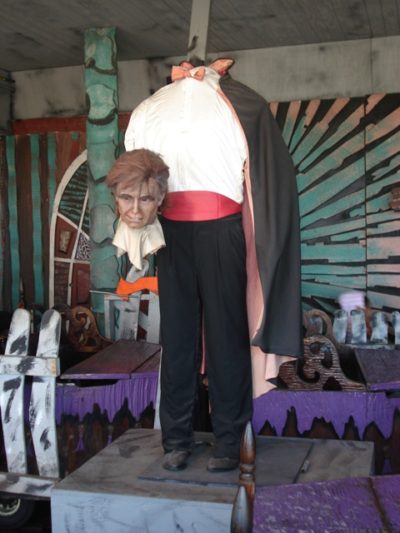
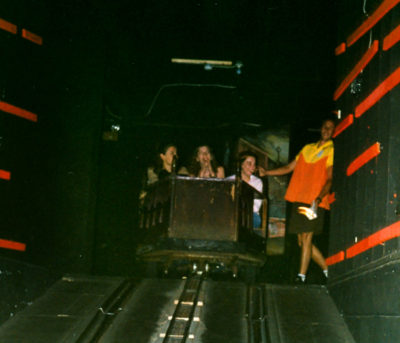
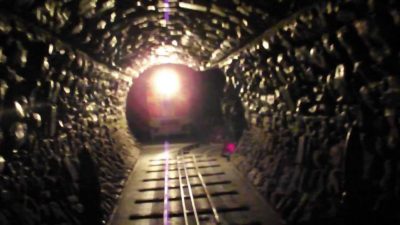
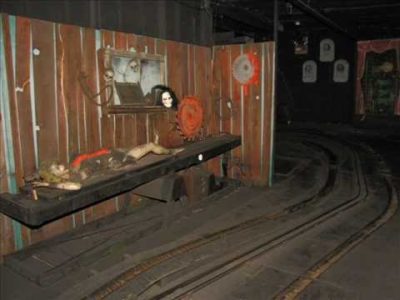
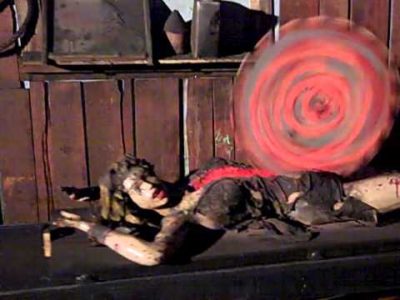
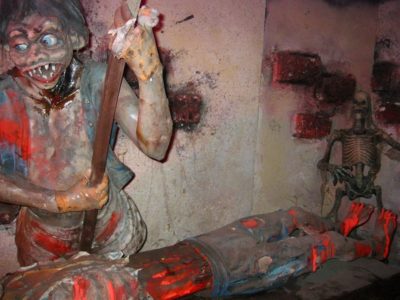
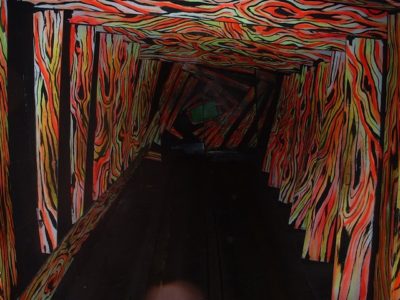
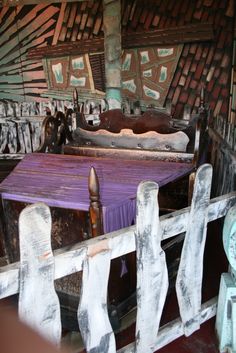
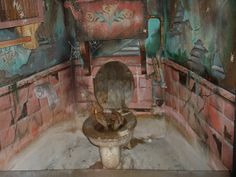
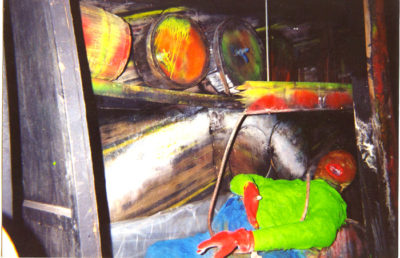
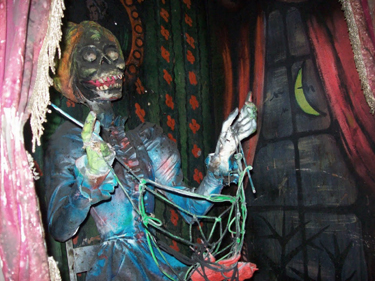
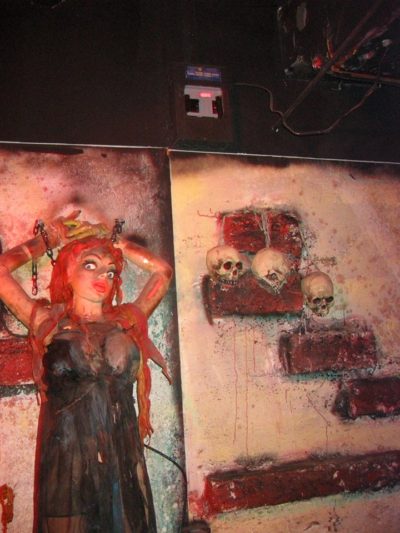
______________
Le Moulin de le Sorcerier (1969 – 2005)
Montreal
__________
Mystery Ride (1960 – 1963)
Holyoke, Massachusetts
‘In 1960, renovations began on Laff in the Dark. An upper level was created. Six new cars were purchased. The transmissions of the new cars were modified to allow a swift and sure climb to the top. Each car had a differential gear in the rear axle and a lot of torque. They came with what appeared to be a colorful primitive ritual mask molded into their front in fiberglass. The ride was themed as an African jungle and called Mystery Ride.The letters on the building were placed on motorized shafts and rocked back and forth. Below the letters was the upper level, which featured a brief U-turn over the loading station. On each side of that were two odd figures with large ears and noses and gum-stick bodies that rocked back and forth. Below that was the station. On the walls next to the entrance and the exit doors were six brightly-painted masks, all different and sporting hideous grins.The masks also rocked back and forth. The clash of colors, the stylized paintings of jungle foliage and animals, the constant movement all over the building – it was a tour-de-force for Spadola and a feast for the eyes. For the interior, Spadola created a wide variety of three-dimensional fantastical scenes, from Hell.’









______________
The Tornado (1960 – 2003)
Lake George, New York
‘The Tornado tells a story. Upon entering, you’re in the tranquillity of farm country, then it gets darker and you hear the swirling winds of an approaching tornado. To your left is a farm family nervously looking ahead to the menacing twister that’s spinning in the foreground. None of these sets are behind chicken wire and the car brings you close enough to study them in detail. Next, you’re headed for the “eye” of the tornado – a rotating disk painted in day glow colors. But before you drive into ground zero, your car weaves down a country road towards some angry-faced trees. It’s here that hidden fans provide the feel of strong winds and the sound effects are much louder. Next, you approach a stack of moonshine that looks like it’s ready to collapse on you. My guess is that it did at one time. Then, you’re driving towards a farmhouse where you see an elderly lady holding on for dear life to a fragment of her porch and a terrified husband and wife whose bedroom is being swept up by the tornado. To your left is a twirling outhouse, and if you look closely, you’ll see someone inside it. Overhead is a still, life-sized cow and some chickens, all suspended by wires. You then find yourself in a chicken coup, but the chickens are motionless. Finally, you witness the aftermath of the storm: shattered debris along the roadside. And just before you exit, there’s a horse in a stable. The horse’s jaw has hinges, indicative that it used to speak – perhaps a conclusive statement. But it’s silent now, giving you a somewhat anti-climatic ride ending.’
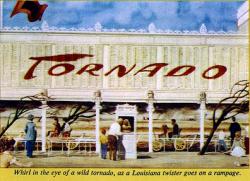
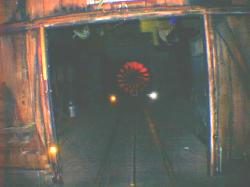
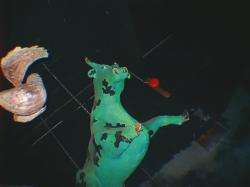
_______________
Phantasmagoria (1972 – 2006)
Tulsa, Oklahoma
‘While many of today’s haunted house rides are geared towards younger patrons, Phantasmagoria is geared towards teenaged riders and adults accustomed to hardcore horror films with its lack of restraint concerning gore. In one portion of the ride there was once a naked woman to tantalize the male riders. However, when the bare bottomed vixen spun around, she revealed that the front half of her body had been skinned down to muscle and bone. The ride is dark, but not without novelties. A waterfall pouring over the track appears to threaten riders with being drenched, but shuts off as the car passes underneath. In one pitch black room, the riders are teased by apparent nothingness, but are startled when a bullhorn blares and headlights reveal the front end of an actual bus, driven by a rotting corpse.’
_____________
Boot Hill (1964 – 1977)
West View Park, PA
‘Rare view of defunct Bill Tracey designed walk through, “Boot Hill” of the vanished “West View” amusement Park, P.A. Check out the “Steer Head” and Horns atop, a common prop of Tracey’s.’
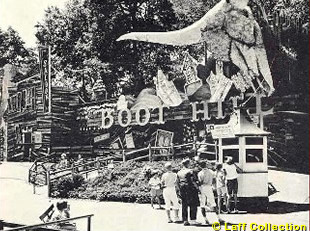
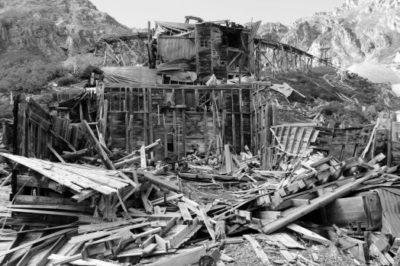
_____________
Maelstrom (1988 – 2014)
Orlando
‘Maelstrom was a dark ride attraction located in the Epcot theme park at Walt Disney World Resort in Florida. Designed by Walt Disney Imagineering, the ride opened on July 5, 1988, in the Norway Pavilion of the park’s World Showcase section. Riders departed from a dock traveling by boat, which turned a corner into a dark tunnel and up the flume’s lift hill. A voice tells riders that those who seek the spirit of Norway face peril and adventure, but more often find beauty and charm. Arriving at the top of the hill, a lit face of the Germanic god Odin hovered above. Riders passed through scenes of seafarers and maritime villages depicting a mythological version of Norway’s Viking days. Entering a marsh, the boat would come face to face with audio-animatronic depictions of Dökkálfar and Ljósálfar from Norse mythology. The trolls, angered by the trespassing boat, cast a spell onto riders as the vehicle began to move backward rapidly, accelerated by hidden conveyor belts underneath the water’s surface. The boats floated briskly past scenes of polar bears and living trees, before coming to a stop on the edge of another waterfall, exposing the Norway pavilion’s main thoroughfare. The backwards edge of the boat peeked out through the facade as the track pivoted to let the vehicle travel forward again. Correctly oriented, the boats plunged forward down a 28-foot (8.5 m) flume into a stormy depiction of the North Sea. After passing very close to an oil rig, the ride came to an abrupt end in a calm harbor of a small village, where the narrator announced, “Norway’s spirit has always been, and will always be adventure.” As guests exited the ride, they had the option of watching a 5-minute tourism film, “The Spirit of Norway”, which highlighted various attractions in Norway including skiing, hiking, and Kjerag mountain.’
_______________
Castle of Terror (1963 – 1978)
Rocky Point, Rhode Island
‘The architectural lines are somewhat distorted, as if the castle had gone through a meltdown. Patrons were left wondering “Was it due perhaps, to whatever was contained inside this Castle of Terror? Had some sinister presence, lurking within, caused the divergence?” This only added to the allure, as all the creepy adornments on this façade gave the riders plenty to consider while waiting in line. A stairway to nowhere ascended from the second floor balcony and was lost behind the dimly lit spires that rose over one of the two “pop-outs” over the midway. Years later, while taking a final tour of this dark ride with the lights on, it was plain to see that this ride was more than just your everyday plywood and papier-mâché creation. Cement and plaster coated metal construction netting was used to form the various turrets and passages – no painted plywood bally for this castle. This allowed the building designers to segue from the rigid, blocked structure you see at first glance to the creepy, cave-like openings that seemed to swallow the unsuspecting into the castle’s darkest recesses. When you added it all up, it was something out of your wildest dreams – or nightmares. All the excess on the exterior couldn’t be worth a 5-cent ride ticket if the Castle of Terror was anything less than – terrifying! Fear not, because the minute your little electric car takes that first jolt into darkness, the sensory overload begins. And those ride cars were works of art unto themselves. Each of the ten or so vehicles sported their own smaller artist’s rendering of the castle’s interior scenes, carefully painted with close attention to detail. For instance, the white car featured the graveyard scene in detail on its back; the red car depicted the Mad Scientist in his laboratory. Of course, the Giant Bat, Count Dracula, and the Spider were all given their own renderings on these multi-colored vehicles. While some dark rides may have themed their cars to the occasion, with a Mardi Gras motif or a padded coffin on wheels, these cars were true originals unique to this attraction. Once inside your vehicle, you found all the key features of a classic dark ride here; quick ninety-degree turns, plenty of wooden “crash” doors, black lights and day-glo paint galore. After barreling through the first series of plywood doors and an angry encounter with Dracula slamming his coffin door, you are yanked up the first chain-lift hill in the Castle’s center room. Though there may have been double-decker dark rides before the Castle of Terror, no other dark ride consisted of two chain-lift hills to take riders both up and down multiple levels. Also located in the castle’s center room is a detailed mural of a sinister hilltop castle, surrounded by scores of bats and other assorted winged creatures.’
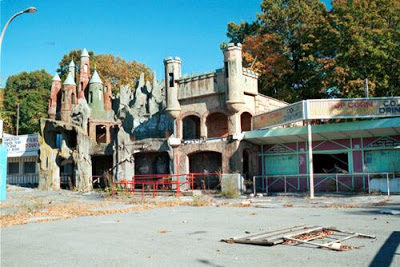
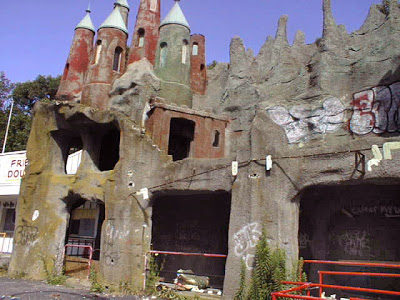
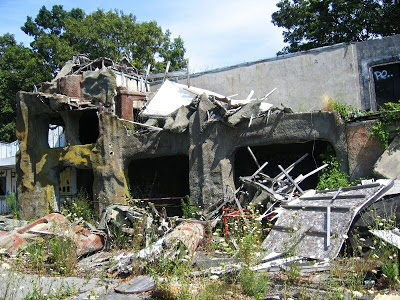
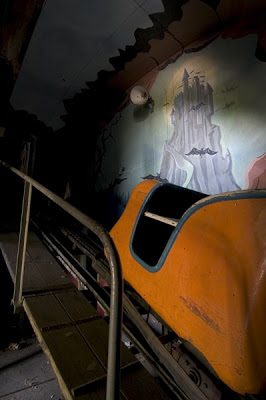
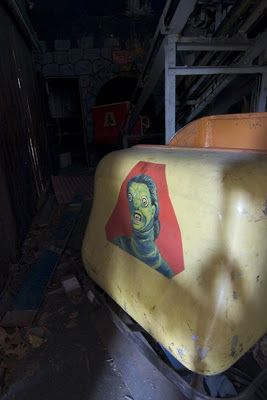
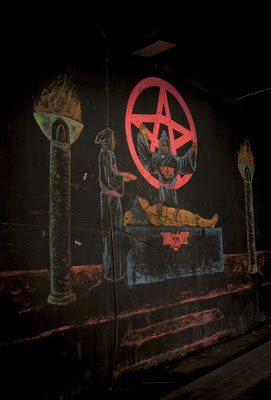
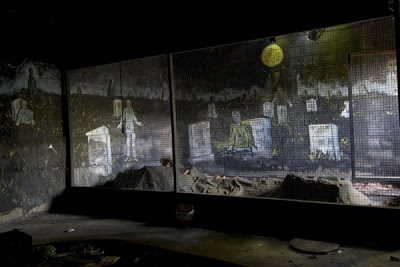
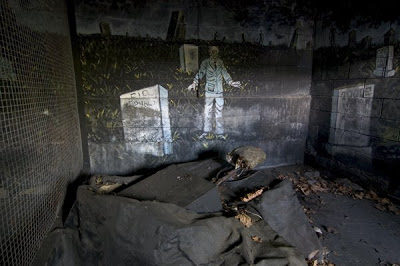
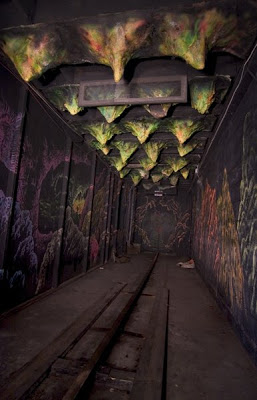
________________
Ghost Ship (1966 – 1969)
Pittsburgh
‘The facade for the roof for the ride featured a giant wrecked sailing ship washed ashore upon the rocks. A hideous skeleton of some large crab monster with a huge human skull for a head sat over the signage for the ride while its ugly face rocked back and forth. Underneath, the whole front of the dance hall building was transformed into a nightmarish underwater graveyard for lost ships. Passengers boarded their two person ship-shaped vehicles on the left side of the platform.Just to the right of the boarding area, a raised sloping platform sat in the middle of the loading/unloading area. Two cave like openings, the left side slightly higher than the right, flanked each side of the sloping platform. From time to time, a large wheeled dinghy would appear out of the left cave and roll down the platform and enter the right cave. Riding within the battered boat would be a hideous skeleton-like figure resembling the Grim Reaper giving waiting passengers and passersby alike a hint of what was in store for adventurous riders. After boarding their vehicle, passengers waited for the ride operator to dispatch them into the Ghost Ship’s winding dark labyrinth. Ghost ShipYou knew it was your turn when a loud buzzer sounded off in conjunction with the operator’s signal light above the tunnel entrance. As the car jerked forward, it moved rather rapidly for a dark ride vehicle and had a strange chain driven motor sound to it. The car made a quick right turn throwing passengers together to enter the tunnel. Once inside, the cars went up a slight inclined ramp and “bashed” through two sets of black doors to enter the building. After your eyes adjusted to the sudden darkness, you noticed that you were in a long mine shaft with eerily glowing green supports. The mine shaft appeared to go on forever as your car sped rapidly down the long corridor. Then suddenly, the car made an abrupt right turn and crashed through the mine wall (another set of double doors). Now, you were in the first of two revolving barrel rooms. The motion of the barrel around the track was quite dizzying and convincing.Immediately at the end of the barrel was the first animated scene, an old, evil looking fisherman or pirate sitting at a long banquet table about to eat some rather unappetizing looking food. What was unusual about this scene was that the whole scene rocked back and forth like Kennywood’s famed Noah’s Ark attraction. The lights within the banquet scene suddenly went out with a large banging noise as the car made a quick left turn into the captain’s quarters of a ship. In earlier years, only large crates and a treasure chest opening and closing were located here. In later years, a large animated polar bear was located here as if ready to pounce on passersby (anything can happen in a traditional amusement park dark ride it seems!). Ghost ShipWithin this room, the cars made a quick right handed U-turn and then sped down a series of dark winding passageways. Another left handed U-turn, and a hideous lobster man appeared from no where.A quick right handed U-turn, and there was an outhouse with a skeleton sitting inside. He pulled the door closed as the lights went out again and the car followed another long dark hallway. At the end of the hallway, a hideous ghoul appeared to be floating towards the car straight towards you, but an abrupt right turn brought the car out of harm’s way. Again, the car crashes through a set of doors, and up over the door frame of the next set of doors was a skeleton with a paint brush and pail. The whole platform that he was sitting on suddenly rolled over as you passed underneath and the paint can’s contents of fluorescent red paint appeared to be spilling out right on top of you! (Actually, it was just a red painted piece of canvas attached within the can that fell out to make it appear that the paint can was spilling.) Through the next set of doors, the cars found their way into a red, horizontally striped room. The red stripes on the walls, however, were on conveyor belts moving slowly downward which created the illusion that your car was rising in elevation. Another well done illusion by the ride’s designers. Another left handed U-turn placed the car into the second spinning barrel room, offering more dizzying illusions just after the moving wall room. Ghost ShipAt the end of the barrel, the next scene was aboard the deck of a ship at sea. A poor, unfortunate pirate was haplessly lashed to the ship’s wheel, spinning in the same direction as the spinning barrel you were in which helped amplify the spinning illusion. As you approached the pirate when you exited the barrel, another right handed U-turn occurred and you were approaching what appeared to be the tentacles of a giant octopus underwater.As you came closer, the creature’s monstrously deformed head appeared with a strange noise, and then the car whisked away in a quick left turn into an underwater graveyard room. Skeletons of dead fish hung from the ceiling and were painted on the room’s walls while bubbling sounds echoed around you. A treasure chest sat on the sea floor where it was being guarded by some sea creature in the far corner of the room. The car made a left turn along the edge of the room as you entered the strobe lit mirror maze. This short, curved mirrored hallway ended very abruptly. At the end of the hallway, two skeletons in a row boat were rocking back and forth among the rocks. Another abrupt right turn, and you were face to face with a large dragon which blew its hot breath at you. Ghost ShipFinally, another right turn and the car was headed down another hallway, this time with cracks of light ahead. You could make out what appeared to be the final doors and the exit to the ride. But separating you from the doors was a huge wall of water pouring down from the ceiling. Just when you thought that you would end up soaking wet before you got off the ride, the waterfall magically stopped, and only a few drops of water landed upon you as you crashed through the final set of doors and back onto Kennywood’s midway.’
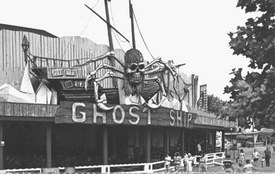

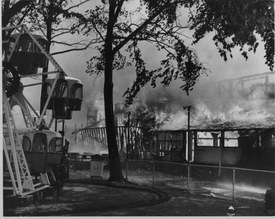
*
p.s. Hey. Here’s a Halloween timed oldie for you concerning two of my favorite topics — the Dark Ride and the Defunct. Enjoy, I hope.




 Now available in North America
Now available in North America 
In their failed state these “Ghost’ attractions are spookier than when they were up and functioning.
A dark ride was my prototype for a Haunted House. Camden Park It’s Jack Kerouac month here in St. Pete. A sort of strange celebration as he literally moved here to kill himself with alcohol rather than commit suicide as he was Catholic. He haunts the old bookstore where he rearranges his books to the higher shelves and sometimes just throws the books in his section on the floor. Remembering some of his fans I have met oer the years who were absolutely rabid. Happy hainting
dennis
dark rides within us
spiralling a hallowen whistledown
pixeldust on his halloween belt
a nail in my mouth
got my solo norway / gaahl show nailed for april next year
as well as my ny solo show in april as well in whatever sewer they vomit up
nothing but love here
and then may can softly claim me in may
my love to you dennis, x
Re Attenuated sex yesterday, back in the early 2000s I designed a poster for our nightclub NEON in Dundee that featured an image from Thomas Ruff’s Nudes. I love that photo series and disappointingly it never got used.
I’m happy to announce that Issue #3 of The Call is online and available here from today! Copies of the limited A5 Risograph zine are £3 and can be shipped anywhere in the world.